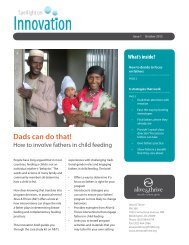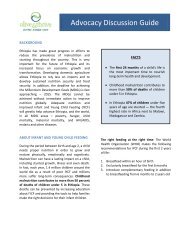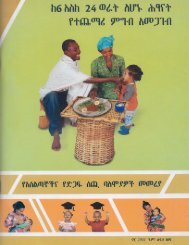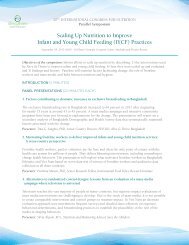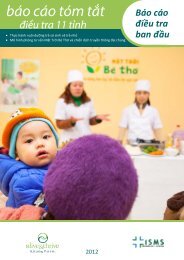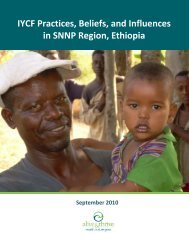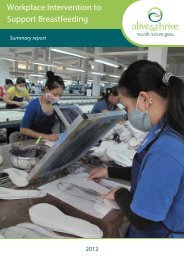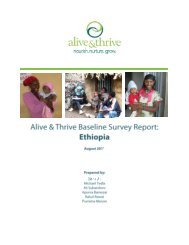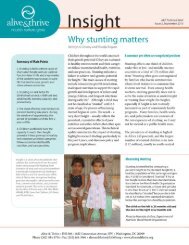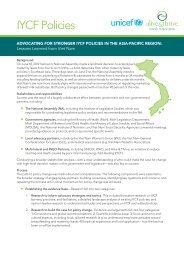IYCF Practices, Beliefs, and Influences in Tigray ... - Alive & Thrive
IYCF Practices, Beliefs, and Influences in Tigray ... - Alive & Thrive
IYCF Practices, Beliefs, and Influences in Tigray ... - Alive & Thrive
Create successful ePaper yourself
Turn your PDF publications into a flip-book with our unique Google optimized e-Paper software.
“If a child is fed with a food that has pepper <strong>and</strong> spice before the age of 2 years, it<br />
causes discomfort to the stomach of the child <strong>and</strong> causes <strong>in</strong>test<strong>in</strong>al parasites.” (A<br />
mother from Tahitay Maichew)<br />
Food Quality <strong>and</strong> Diversity: Dur<strong>in</strong>g the opportunistic observations, mothers were seen feed<strong>in</strong>g their<br />
children <strong>in</strong>jera with shiro more frequently than other foods. The shiro was prepared from ground beans<br />
or pea flour to which oil, pepper, <strong>and</strong> onion were added. Some mothers were also observed feed<strong>in</strong>g their<br />
children porridge, unleavened bread, <strong>and</strong> bread soaked <strong>in</strong> a mixture of water <strong>and</strong> sugar. One mother<br />
from Hawizen gave boiled egg with the porridge. Unleavened bread, <strong>in</strong>jera, porridge, gruel, bread, milk,<br />
<strong>and</strong> egg were commonly fed to children the day before the data collection for this study. A few mothers<br />
reported that they gave their children kale. Table 3 presents the types of foods given to children of<br />
different age groups <strong>in</strong> the three communities.<br />
No one mentioned add<strong>in</strong>g a variety of foods to the child’s porridge. None of the children was fed with<br />
chicken, meat, fruits, or peanuts. One mother from Raya Azebo reported that her child ate noth<strong>in</strong>g the<br />
day before data collection because he was sick.<br />
The majority of the study participants expressed their will<strong>in</strong>gness to enrich the child’s porridge by<br />
us<strong>in</strong>g different food items. However, they also stated that they were unable to do so for economic<br />
reasons or were unsure how to prepare nutritionally rich porridge. This f<strong>in</strong>d<strong>in</strong>g was similar to the<br />
<strong>in</strong>formation obta<strong>in</strong>ed from HEWs.<br />
Most of the mothers reported that it was not affordable to purchase vegetables, fruits, a variety of<br />
cereals, meat, egg, <strong>and</strong> milk for their children. A mother from Hawizen mentioned that besides the cost<br />
of the foods, she th<strong>in</strong>ks that her child is too young to eat vegetables <strong>and</strong> meat.<br />
“Orange fruits <strong>and</strong> vegetables are not available <strong>in</strong> the area, <strong>and</strong> my economic<br />
status doesn’t allow me to purchase these foods.” (A mother from Tahitay Macho)<br />
“We feed our children semisolid foods such as gruel start<strong>in</strong>g from 6 months of<br />
age, porridge from 7 months of age, <strong>and</strong> unleavened bread, <strong>in</strong>jera, <strong>and</strong> ambasha<br />
start<strong>in</strong>g from the first year.” (A father from Tahitay Macho)<br />
12



